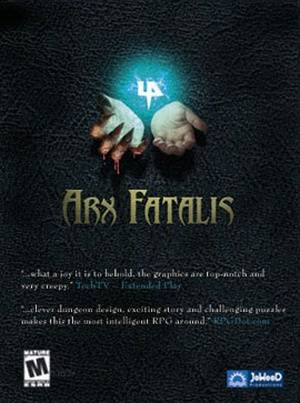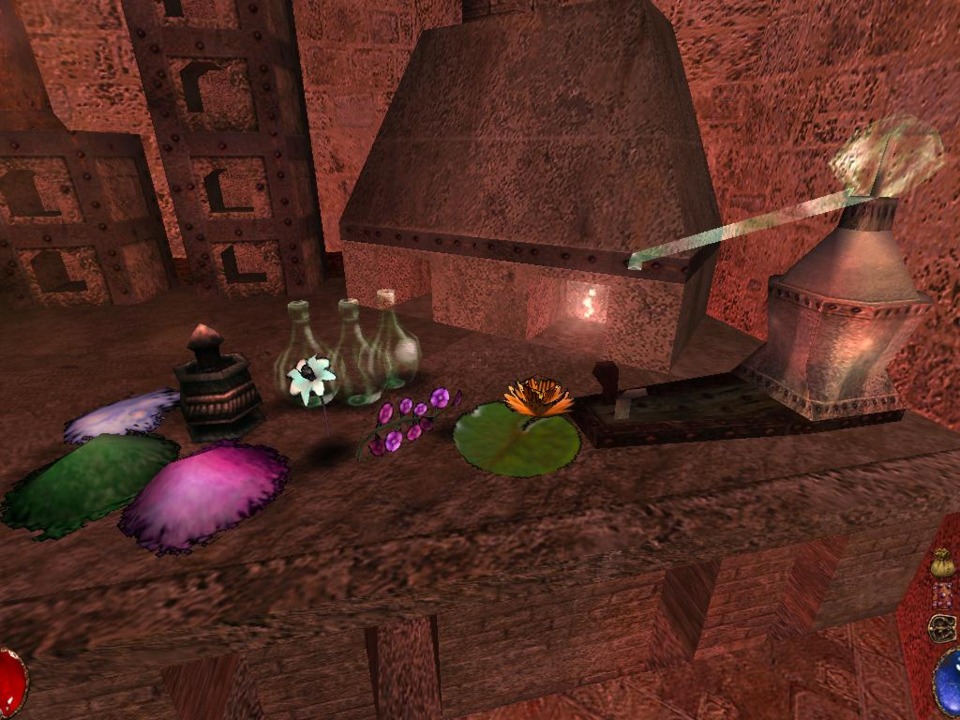May Millennials 4: Arx Fatalis (Outro)
By Mento 0 Comments

Turns out there was a lot of information I either elided or flat out misinterpreted when writing the Arx Fatalis Intro, so let's start with that. Perhaps the most significant of omissions was the fact that Arx Fatalis was the inaugural game of the French developer Arkane Studios, better known these days for Dishonored and Prey - it's very evident after a few hours of Arx Fatalis where Arkane first started developing their gift for environmental storytelling, of the type where you have a skeleton surrounded by props that tells its own subtext-only story of what may have happened to this luckless fellow. Arx Fatalis is also even more explicitly based on Ultima Underworld than I had first thought: the entire game is set in eight floors of a dungeon, with certain non-dangerous floors - like the first, which houses the human kingdom of Arx and the local outpost - based within that structure rather than sitting outside it like many hub cities do in other dungeon crawlers. Floor maps can have alternative passageways to higher and lower floors to create some navigation puzzles, and sometimes whole sections of the floorplan are given over to separate structures: the immense crypt of King Poxcellis takes up a decent chunk of five dungeon floors, mostly existing to the bottom right of each map as a separate entity (though it has a few emergency exits to connect it to the "main" dungeon areas).
When I finished with my early impressions, I was within a stone's throw of the city of Arx, the game's main hub. What I didn't anticipate was how much the game suddenly opens up when you get there. For the game's opening act, you bounce between the first three floors - the second contains the goblin prison you wake up in, while the third features a small camp of affable troll miners - before eventually finding a way to the city, making do with the weak spiked clubs that goblins drop and any half-beaten leather armor that you're lucky to find. Once I was done with my first quest in Arx - which featured a brief revisit to the troll king - I was decked out in powerful magical armor, had a decent longsword weapon, acquired about ten more runes giving me a spellbook that was half full of handy spells (including heals, fireballs, poison cures, invisibility, and magic missiles) instead of a single cantrip for lighting torches, had unlocked the game's teleporter fast travel system, had three vendors to sell my trash to, had my own room in the castle with two storage boxes, and had access to an alchemy lab where I could brew my own healing and mana potions using the weeds I'd been picking up everywhere. It was honestly a little overwhelming: I felt like I had gone from having too little power to too much, and while the game would still continue to challenge me - there's some real tough jerks on the lower floors, and the game seemed to love dropping liches on me while I was exploring the crypts - it's amazing how quickly things just die when you're throwing fireballs and incinerate spells at them with abandon. It was later when I was also able to summon demons, levitate, slow down time, double my movement and attack speed, disable any trap magically, enchant enormous flaming swords of doom, and activate switches from a distance with telekinesis that I realized that perhaps magic was a little overpowered in this game after all.

Suffice it to say there was an enormous gulf between my experience playing the first few hours of the game for the early impressions blog and the experience almost immediately afterwards. For the better, I think: having access to all those conveniences really made me start enjoying the dungeon crawling from that point on, knowing I could just bail and warp back to town for some R&R. It's not like the best gear couldn't be found until much later - you eventually find a set of armor that the bad guys were wearing and... dang, it's no wonder everyone's so scared of them - and many the game's puzzles and challenges were often built irrespective of what the player character's build or level might be. A great example of this, and of the type of instance that I loved conceptually but disliked immensely in practice, is the final floor of the dungeon, which was given over to the industrious dwarves so they could continue mining ever downward. If you've seen or read The Lord of the Rings, or played enough Dwarf Fortress for that matter, you could probably surmise what happened to them: they found something while digging, and that something left nothing but viscera and destruction in its wake. When you get there yourself, looking for valuable mithril to turn into a powerful god-killing weapon, you have to spend the first half of your exploration of the deserted dwarf colony running away from this invincible toothy abomination, eventually leading it into the dwarf's industrial crusher like the original Terminator movie. It takes a subsequent dip into molten lava to kill it for good (recalling the second Terminator movie, I suppose). It creates a problem that you can't solve via magic - the entire dwarven colony is housed within an anti-magic field, making me more vulnerable than I was used to - or weapons, since everything bounced off the thing's obsidian-like hide. You had to rely on your wits and speed instead, poking around the dwarven machinery for a hint of where to go next knowing that death was just behind you (provided it didn't get stuck on the level geometry again). Instances like those are what made Arx Fatalis stand out, even amongst the many other distinctive dungeon-crawler CRPGs I'd been playing this month.
Ultimately, I thoroughly enjoyed Arx Fatalis. The Arx Libertatis fan patch/remake helped, of course, as did figuring out the renderer settings to make the game buttery smooth instead of the enormous slowdown factory it became once Arx opened up with its many wandering NPCs (it was seriously so bad that I couldn't even open doors, the lag was that great). Choosing the curious magic rune-tracing system - one that could be finnicky when it came to recognizing the runes you were invoking in the air with the mouse, but saved by the pre-casting save function - over yet another clunky early '00s melee combat system was clearly the smart choice, given how versatile and powerful magic ended up becoming. Having that level of ability, where there was a spell for almost every situation that a thief or fighter would have to approach the hard and stupid way, really made me reassess how infrequently I play mages in other games. There's also that surreal moment when you realize you're (minor spoilers) an interdimensional cop from a metaphysical universe of pure energy that is regularly sent out to prevent godlike entities from manifesting in physical dimensions like Arx that was perhaps even more intriguing than the premise of Planet Arx's sunless eternal winter forcing everyone underground. Prey's space station taken over by Vermicious Knids doesn't seem quite as far-fetched in comparison.
That's going to conclude my Arx Fatalis coverage, as well as the May Millennials feature for 2019. While I'm not sure I needed to play four decades-old CRPGs in a row, I'm glad I picked these four in particular. I think it would fair to say that many would-be CRPG developers were looking to break the stranglehold of BioWare, Black Isle, and the Infinity Engine, which at the time had the D&D license and the attention of the CRPG audience, or the dozens of semi-mindless loot RPG "Diablo clones" that were popping up everywhere. Each of the games covered this month - Star Wars KOTOR 2: The Sith Lords, Severance: Blade of Darkness, Gothic, and Arx Fatalis - all had an emphasis on story and world-building elements and a certain subversiveness to their elevator pitches and executions, from the iconoclastic symbolism of eliminating the old guard (KOTOR 2), adapting a more deliberate and measured approach to action-RPG combat (Blade of Darkness), emphasizing a living world with rules in which you had to either adapt or die (Gothic), to just making every plot point as out-there as possible (Arx Fatalis). When I think of ageless CRPGs, it's the ones that dare to be different that are the least likely to vanish into the mists of time.

0 Comments